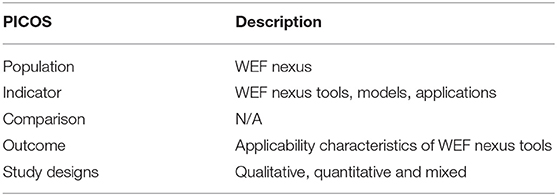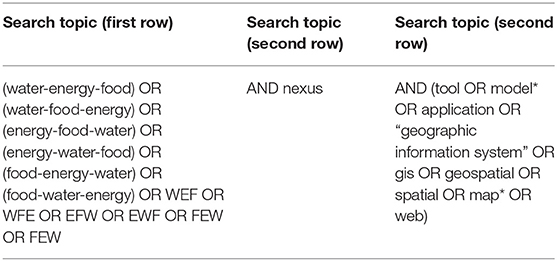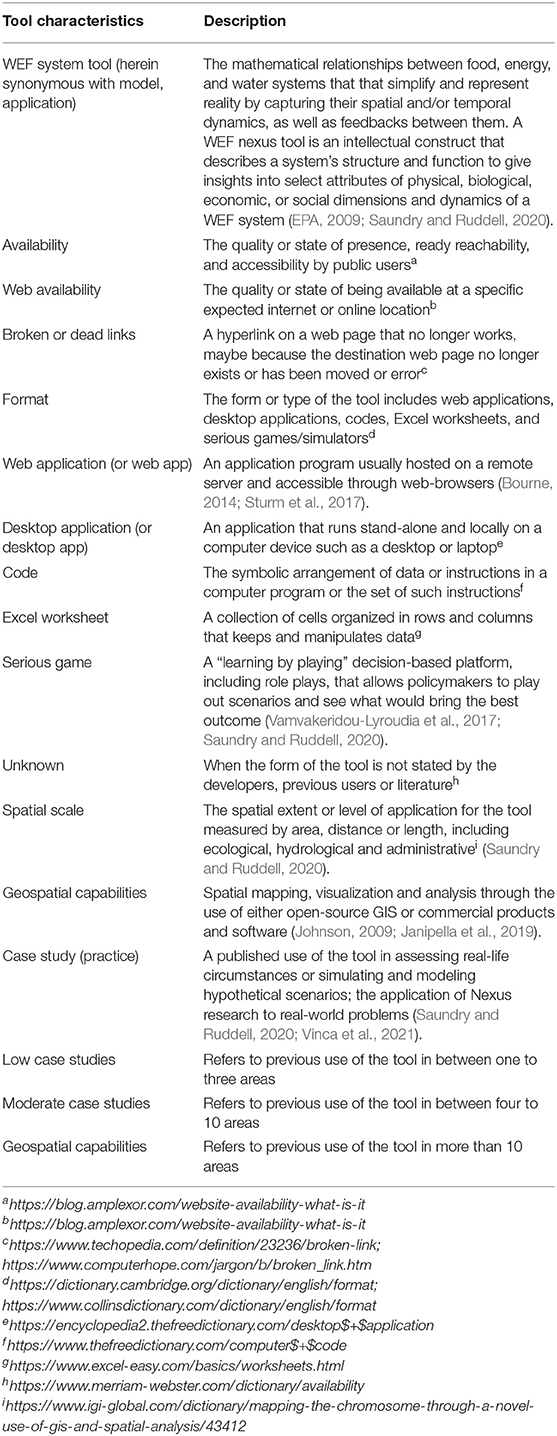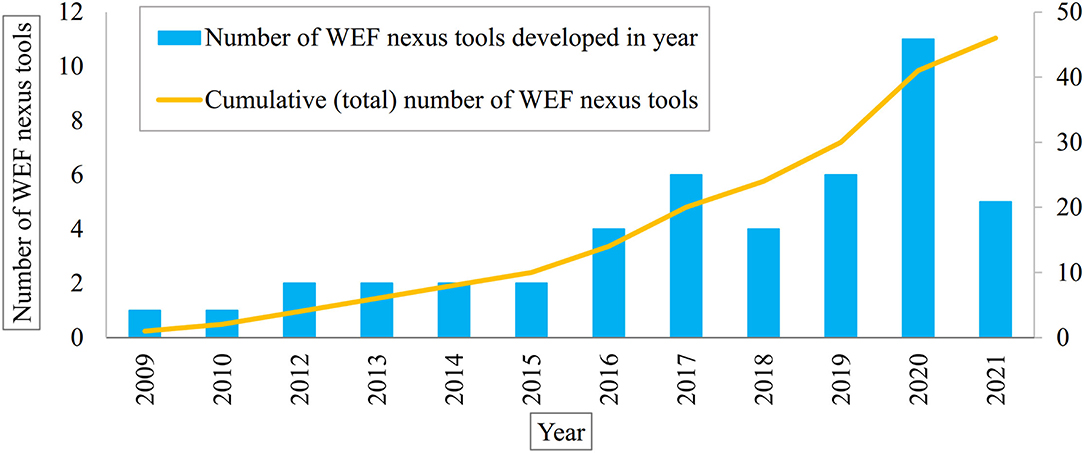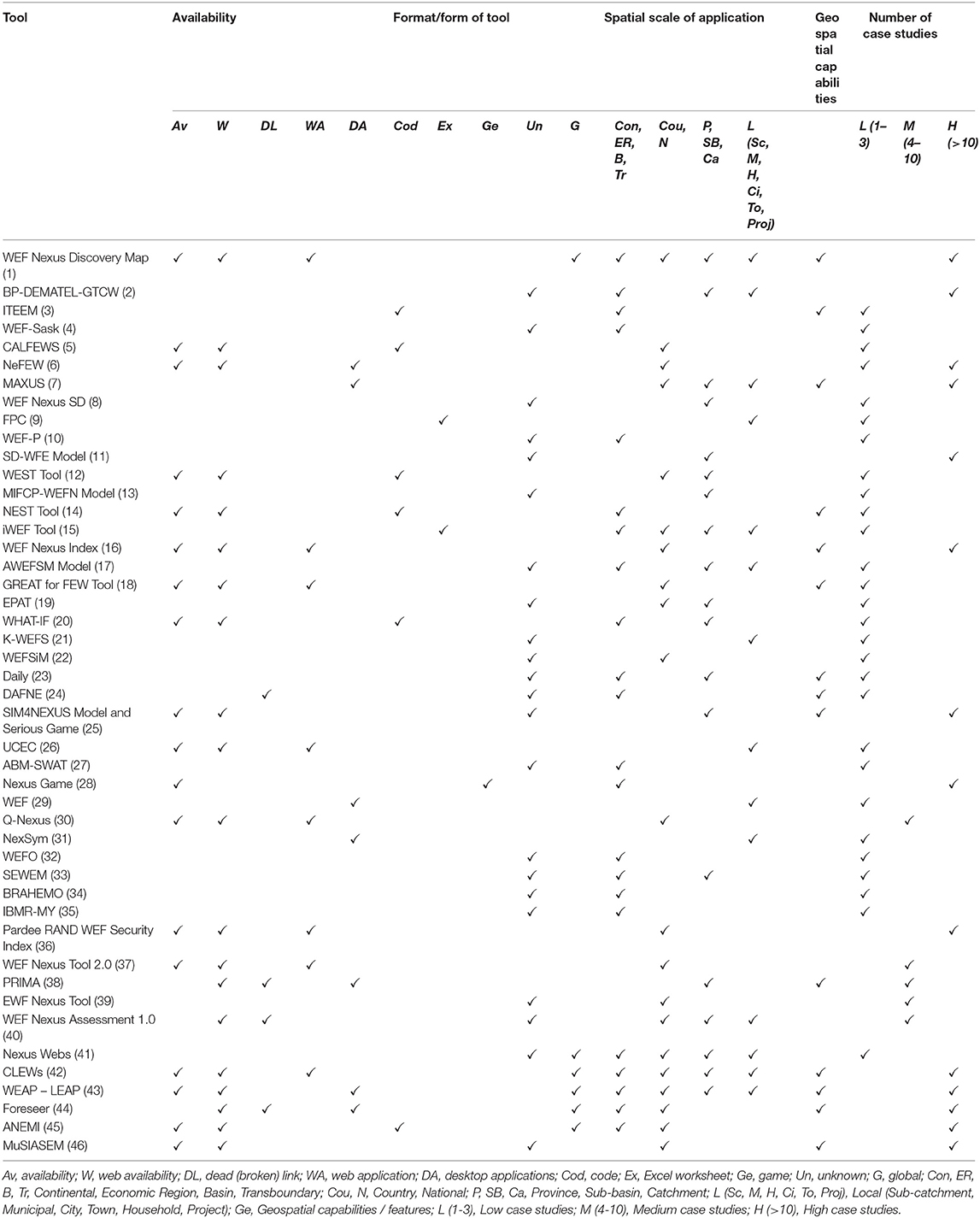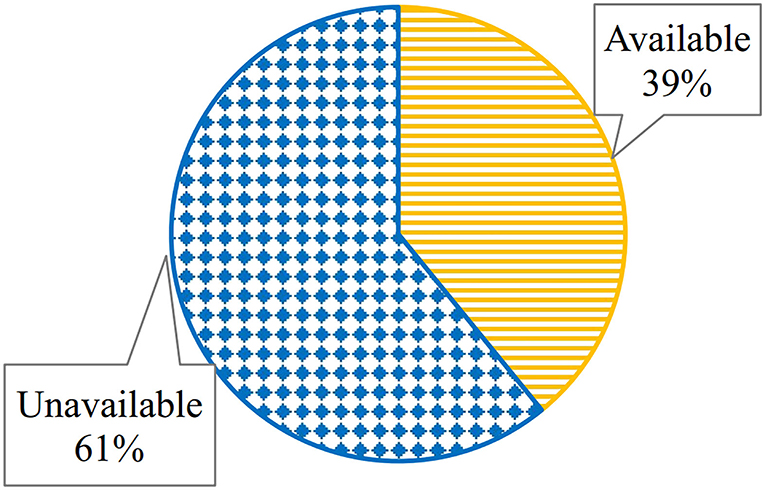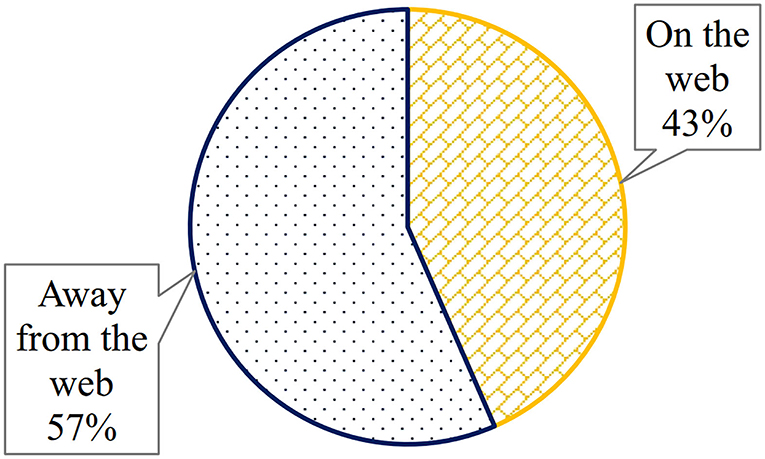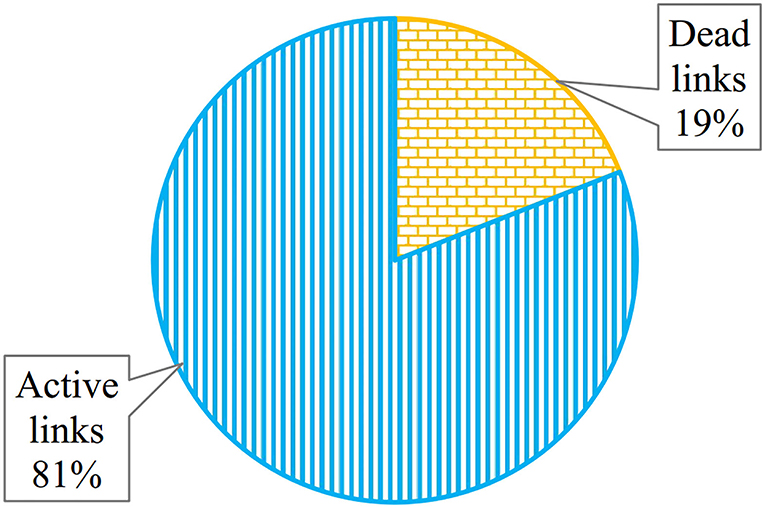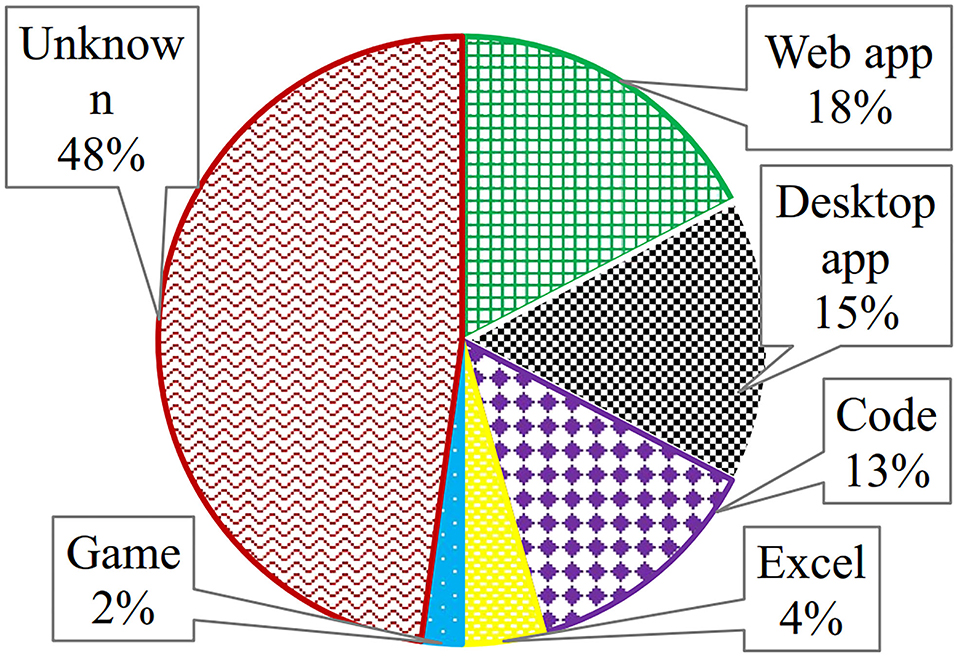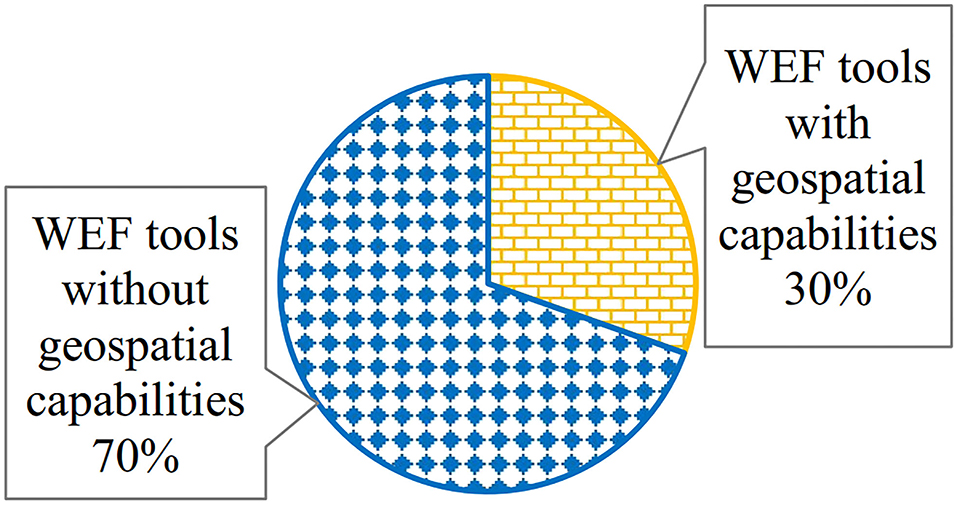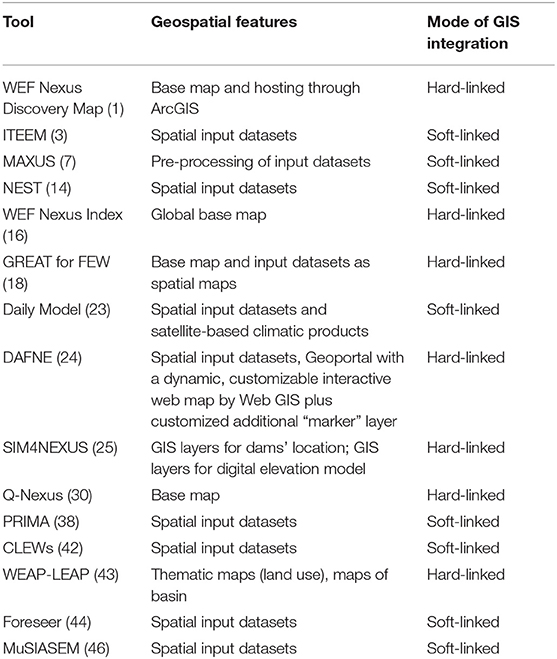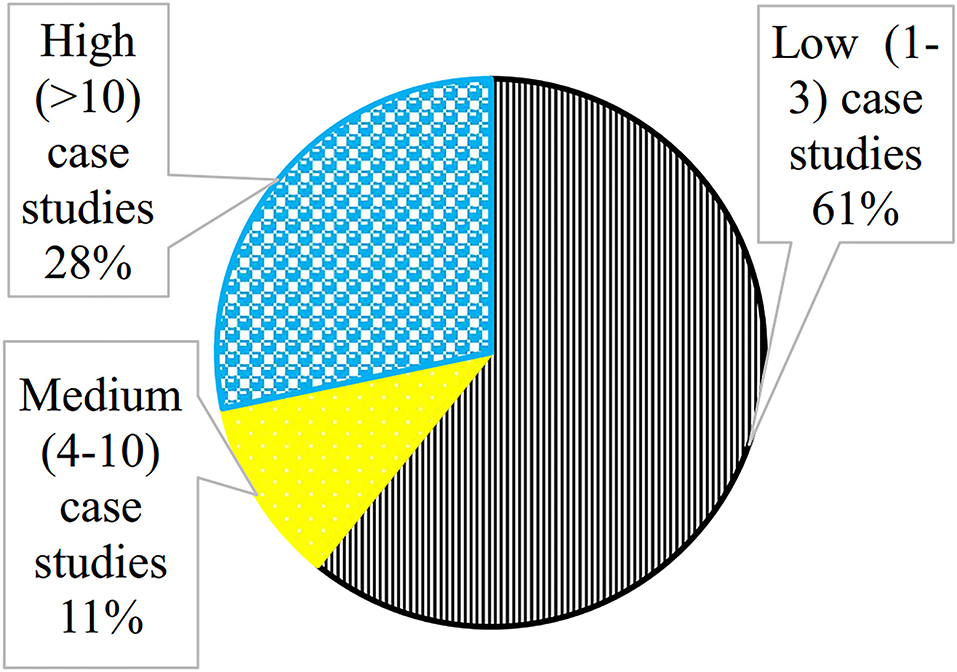- 1School of Engineering, University of KwaZulu-Natal, Pietermaritzburg, South Africa
- 2Centre for Transformative Agricultural and Food Systems, School of Agricultural, Earth and Environmental Sciences, College of Agriculture, Engineering and Science, University of KwaZulu-Natal, Pietermaritzburg, South Africa
- 3Origins Centre, University of the Witwatersrand, Johannesburg, South Africa
- 4Department of Water and Sanitation, Mzuzu University, Mzuzu, Malawi
- 5International Water Management Institute (IWMI-GH), West Africa Office, Accra, Ghana
Sector-based resource management approaches partly contribute to the insecurities in water, energy and food sectors and resources. These approaches fail to acknowledge and capture the interlinkages between these connected resources, a key strength in the water-energy-food (WEF) nexus approach. However, the multi-centric, multidimensional, and spatiotemporally dynamic WEF nexus is complex and uncertain, thus requiring dedicated tools that can unpack it. Various sources have blamed the slow uptake and practical implementation of the WEF nexus on the unavailability of appropriate tools and models. To confirm those claims with evidence, literature on WEF nexus tools was searched from Scopus and Web of Science and systematically reviewed using the PRISMA protocol. It was found that the WEF nexus tools are being developed increasingly, with a current cumulative number of at least 46 tools and models. However, their majority (61%) is unreachable to the intended users. Some available tools are in code format, which can undermine their applicability by users without programming skills. A good majority (70%) lack key capabilities such as geospatial features and transferability in spatial scale and geographic scope. Only 30% of the tools are applicable at local scales. In contrast, some tools are restricted in geographic scope and scale of application, for example, ANEMI 3 and WEF models for large and household scales, respectively. Most (61%) of the tools lack wide application in actual case studies; this was partly attributed to the tools not being readily available. Thus, efforts should be made to disseminate and ensure end-users' uptake and application of developed tools. Alternatively, the user-friendly tools should be developed on-demand as requested and inspired by potential clients. Developers should consider utility, transferability and scalability across uses and users when improving existing tools and developing new tools so that they are adaptable, only requiring new, specific location-adapted inputs and data. Where and when it is necessary to capture spatial dynamics of the WEF nexus, tools should be geographic information system (GIS)-enabled for automatic WEF nexus location selection, geospatial mapping, and visualization. Such GIS-enabled WEF nexus tools can provide a bird's eye view of hotspots and champions of WEF nexus practices.
Introduction
Water, energy, food, and land drive economic and social development. These strategic resources are degrading and over-exploited by, among many factors, population growth, economic development, dietary shifts, urbanization, pollution, as well as changes in culture, technology, and climate (Mabhaudhi et al., 2016). Projections for the near and distant future expect increased demand for water, energy, and food (Hoff, 2011; IRENA, 2015; Martinez-Hernandez et al., 2017; Tashtoush et al., 2019; Schull et al., 2020). The insecurities of these key resources are further amplified by the disconnected policies and sector-focused approaches to resources management, which ignore the resource interlinkages, coexistence and transboundary nature (Leck et al., 2015). Integrated management of the resources that underpin the water, energy and food security avoid the unintended effects of sector-based approaches to unlock the potential for achieving the Sustainable Development Goals (SDGs) (de Andrade Guerra et al., 2021). This has led to the pursuit of the water-energy-food (WEF) nexus approach as a holistic, integrated approach to managing natural resources that was proposed in the Bonn 2011 Nexus Conference for WEF Security Nexus Solutions for the Green Economy (Leck et al., 2015; Schull et al., 2020). Water, energy and food are inextricably and intrinsically linked in ways that actions in one sector influence the others, synergistically or often adversely, at different levels and scales (Hoff, 2011; IRENA, 2015). The WEF nexus has gained undivided attention in the agenda of research, policy dialogue and development (Bazilian et al., 2011; Eftelioglu et al., 2017). This has seen WEF nexus being mainstreamed into thematic areas, strategies and policies by local, regional, and international institutions, governments, and organizations (SADC, 2016; GWP-SA, 2019a,b). The actual nature and significance of interconnections between the WEF resources are context-specific, hence the need to explore and understand the interdependence of water, energy and food security and the natural resources that underpin their security (Liu et al., 2017; Salam et al., 2017). Despite the hype of the WEF nexus agenda, several authors concur that the actual translation of the theory into practice is lagging hence the need to investigate the limited uptake of the promising approach (Byers, 2015; Daher and Mohtar, 2015; Liu et al., 2017; Galaitsi et al., 2018; McGrane et al., 2019; Nhamo et al., 2020a; Naidoo et al., 2021).
WEF nexus tools were previously reviewed on several characteristics, including feedback analysis, optimization and visualization (Wicaksono et al., 2017; Wicaksono and Kang, 2019), informing policy (Shannak et al., 2018) as well as entry requirements, exits and analytical capabilities (Rosales-Asensio et al., 2020). Mannan et al. (2018) reviewed analytical features of WEF nexus tools, while Dai et al. (2018) focused on model types, spatial scale, purpose and nexus challenge level. Dargin et al. (2019) delved on the complexity of WEF nexus tools, while Flammini et al. (2014), IRENA (2015), Kaddoura and El Khatib (2017), and Shinde (2017) reviewed their suitability, analytic modeling capabilities, inputs, and outputs. Reviews by Albrecht et al. (2018) and Zhang et al. (2018) included concepts and methodologies in the WEF nexus and tools.
These previous studies usually reviewed <10 different WEF nexus tools to provide useful information on the characteristics of different WEF nexus tools. They also overlooked other significant characteristics that may undermine the applicability of these tools. Such characteristics or criteria include availability, format, application scales, geospatial analytic capabilities and previous use, among others. Eftelioglu et al. (2017) and Hiloidhari et al. (2017) highlighted that geospatial analytic capabilities in WEF nexus tools solve spatial decision problems because WEF nexus tools and geographic information system (GIS) are complementary. GIS is a computer-based information system and spatial decision-making tool that supports the precise assessment of distributed WEF resources, thereby addressing economic and environmental goals (Johnson, 2009; Janipella et al., 2019). Thus, GIS-enabled WEF nexus tools assist in providing a bird's eye view for analysis, comparison and identification of WEF nexus hotspots and champions, with the possibility of exploring impacts of interventions and transfer of good practices and technology (Daher and Mohtar, 2015; Fernandes Torres et al., 2019; Lin et al., 2019). WEF nexus tools and GIS can be integrated through “hard-linking” and “soft-linking.” The former effectively automates the exchange of input and output data between the WEF nexus and GIS for analysis, mapping, and visualization. “Soft-linked” coupling requires the user to manually prepare and transfer information, which is cumbersome and somehow prone to error (Eldrandaly, 2007; Ramos et al., 2019). The status of geospatial analytic capabilities in existing WEF nexus tools is unknown and needs to be addressed. While geospatial capabilities are not a panacea to analyses, they are useful for allowing analyses at different spatial scales and visualization of results in a way that is easier for users and decision-makers to understand and utilize. Also, the trend in models now-a-days has been to add the functionality so that users have an option to use it if they need to.
The WEF nexus field is rapidly evolving, and it is expected that many new tools were developed in addition to the previously reviewed and more will still be developed. Some critical issues on the characteristics of WEF nexus tools remain vague. For example, what is the general historic and current trend in developing WEF nexus tools? How accessible are the tools that have been developed and reported by other users (Byers, 2015)? Is there a lack of WEF nexus tools and, is it justified? What are they likely to find if a user (new or old) searches online for WEF nexus tools? What are the formats of existing WEF nexus tools? Can the existing WEF nexus tools handle spatial data to characterize the WEF nexus spatially? If yes, how are geospatial capabilities incorporated in existing WEF nexus tools? What are the least and most popular WEF nexus tools in case studies? Thus, there is a need for an updated review of WEF nexus tools to clarify WEF nexus tools' status and trends of development, their availability and accessibility, format, spatial scale of application, geospatial capabilities and their application in previous case studies. The global aim of this study was to provide a review of the state-of-the-art of WEF nexus tools and their suitability in supporting the implementation of the WEF nexus approach. To fulfill this aim, this study sought to systematically review the available literature and potentially address the following specific objectives to:
i. assess the historic and current trends in the development of WEF nexus tools;
ii. provide an inventory/compendium of existing WEF nexus tools;
iii. review the availability, format, spatial scales of application, and geospatial analytic capabilities of existing WEF nexus tools; and
iv. assess the application of existing WEF nexus tools in previous case studies.
This review will serve as an update on new and old users' WEF nexus tools and a starting point for present and future developers who intend to improve existing or create new WEF nexus tools. Secondary to this and without necessarily comparing WEF nexus tools, this review is intended to be a knowledge synthesis to guide and inform interested users of WEF nexus tools on what tools to use under different contexts. This will enhance the quick, easy and effective selection of WEF nexus tools for different conditions and requirements in facilitating the implementation of the WEF nexus approach.
Materials and Methods
This study conducted a WEF nexus tools systematic review by mapping broad literature to answer questions regarding development trends, availability, format, spatial scale, geospatial analytic capabilities, and case studies. These characteristics were excluded in previous reviews which focused on concepts, methodologies, complexity and analytical capabilities. Although geospatial tools are useful for certain problems but not for all, interested users need to be guided and informed on status of geospatial analytical capabilities in existing WEF nexus tools. The review was done step-wise, guided by the Preferred Reporting Items for Systematic Reviews and Meta-Analyses (PRISMA) protocol (Moher et al., 2009), which assist in systematically searching, identifying, and selecting articles on search platforms and reviewing them through appraisal and synthesis of research evidence (Grant and Booth, 2009). Page et al. (2021a,b) went on to update, further explain and elaborate PRISMA, which was also applied by Fernandes Torres et al. (2019) in reviewing literature for proposing a systematic procedure of the nexus concept. The PRISMA flow diagram (Figure 1) was conveniently generated with the user-friendly open-access R package and ShinyApp for PRISMA Flow Diagram1 by Haddaway et al. (2021b), as recommended by Page et al. (2021a). The PRISMA steps involved, among others, eligibility criteria, information sources, search strategy, screening, selection, data collection, defining data items, and analysis.
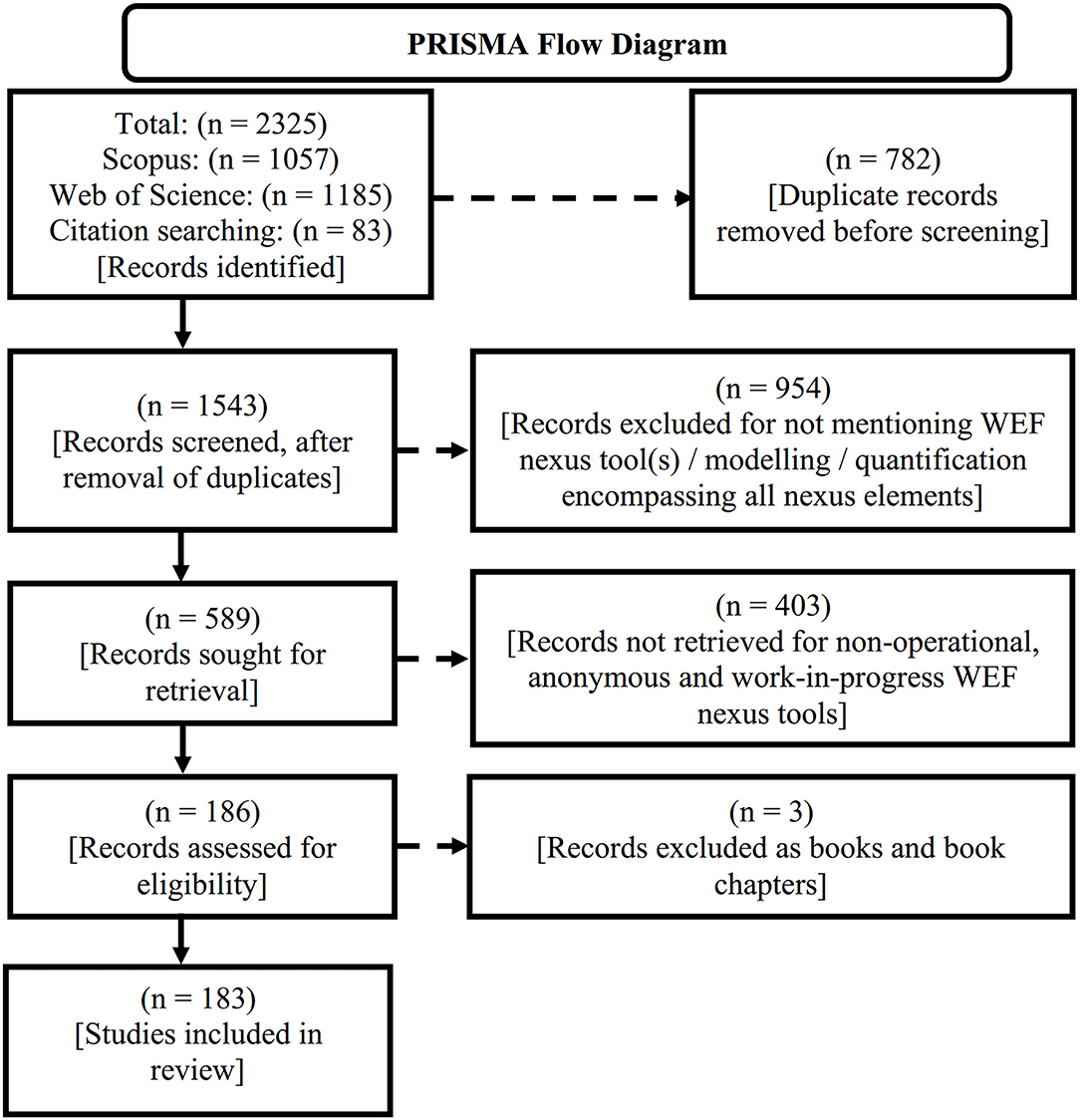
Figure 1. The PRISMA 2020 framework and flow diagram for the systematic review, which includes searches of databases and other sources (adapted from Haddaway et al., 2021a,b and Page et al., 2021a,b).
Eligibility Criteria
The study used the population, indicator, comparison, outcome and study design (PICOS) strategy, which limits the number of irrelevant articles (CRD, 2006; Methley et al., 2014) (Table 1). The PICOS strategy informed the search strategy and the subsequent inclusion-exclusion criteria. Given that the WEF nexus is a fairly novel area of research, broad eligibility criteria were adopted for publications mentioning the development and application of WEF nexus tools. In this regard, only studies with named and operational WEF nexus tools were included, excluding anonymous and non-operational tools.
Information Sources and Search Strategy
The potentially relevant studies in the literature were searched using the same search criteria within two online literature databases, Scopus2 and Web of Science Core Collection (WoS)3 (Accessed on 02 July 2021). These two multidisciplinary databases were selected for their comprehensive coverage and high-quality scientific publications that allow systematic review. Their journal coverage is also remarkably greater than other common databases, even in natural science and engineering disciplines. In addition, citation searches were conducted in reviews to identify WEF nexus tools and their corresponding publications that could be missed in Scopus and WoS databases, including those by international organizations such as Food and Agriculture Organization (FAO) and International Renewable Energy Agency (IRENA). The search criteria in the two databases (Scopus and WoS) involved searching topics using Boolean expressions. The search topics were formed from the keywords “nexus, tool, model, application, spatial, map, geographic information system, GIS,” together with iterations of “water, energy, food” and WEF. The details of the search topics used are presented in Table 2.
Consideration was given to peer-reviewed papers (articles, reviews), scientific book chapters, papers from proceedings and materials from special issue editorial material, institutional documents including dissertations, theses, or technical papers, all written and published in English. The WEF nexus approach, tools and integration of geospatial features are still novel. Thus, the date of publication, geographic scope, journal disciplines and impact factors were kept open to capture all WEF nexus tools and versions, from earliest to latest. All records obtained from Scopus, WoS, and citation searches were combined to facilitate the removal of duplicates.
Screening and Selection of Studies (Inclusion and Exclusion Criteria)
In line with the objectives of this systematic review, the titles, abstracts, and keywords of the searched studies were reviewed and screened for selection. The screening was in favor of publications on (i) WEF nexus tools that have an operational version(s) instead of proposed or work in progress, and (ii) capturing at least all three components of the WEF nexus: water, energy, and food. Sometimes the “land” was considered a proxy for the food component since it is a key element directly linked to food production. Secondly, books and chapters were excluded because they replicated some published journal articles. Eventually, the eligible papers were retrieved for review. These eligible papers and sources may not include all the WEF nexus literature out there. However, they best represent the previous work relevant to addressing and fulfilling our research questions and objectives.
Collecting Data
A data extraction sheet was designed in simple, flexible, and functional MS Excel based on the study objectives. Key data on the selected papers were extracted from the eligible studies and organized in the data extraction sheet. These were organized in columns by the tool's characteristics, including acronym, authors/developers, year of initial development, availability, format/form, the spatial scale of application, geospatial capabilities, and the number of previous case studies. The sub-columns for availability contained general availability, web availability, and dead links. The sub-columns for the column for format were web applications, desktop applications, code, Excel, serious games and unknown. The sub-columns under spatial scale of application presented five classes namely (i) global, (ii) continental/economic region/basin/transboundary, (iii) country/national, (iv) province/sub-basin/catchment, and (v) local including sub-catchment/municipal/city/town/household/project. The sub-columns under the column for number of case studies included three classes according to frequency, namely low (one to three), moderate (four to 10), and high (more than 10).
Data Items and Analysis of Studies
The characteristics of the WEF nexus tools used in this study were criteria briefly defined and described (Table 3) from previous related reviews (Flammini et al., 2014; IRENA, 2015; Shinde, 2017; Dargin et al., 2019) as well as authors' discretional synthesis.
All the tool characteristics defined in Table 3 are desirable attributes in the intended users' applicability of WEF nexus tools. For example, the availability and accessibility of a WEF nexus tool in the public domain is a key prerequisite to its applicability by the intended users. Thus, tools' links provided by developers and previous users, such as web addresses and digital object identifiers (DOIs), were tested. On encountering broken or dead links, a basic search for the tool was conducted on the tool's related website or Google Search Engine4. All evidence of the tools' characteristics was gathered from literature without contacting the authors/developers to avoid bias. The results were presented as tables and charts for analysis, visualization, and interpretation.
Results and Discussion
The pursuit for the WEF nexus approach has seen the advent of several tools for analyzing, modeling, and simulating the WEF nexus in terms of resource supply, demand, nexus indicators and indices. This section presents the findings from reviewing the searched literature against the characteristics and criteria that was previously presented in Table 3.
Literature Search
The detailed results of the search and selection process are shown in the flow diagram in Figure 1. Initially, 1,057, 1,185, and 83 records were obtained from Scopus, WoS, and citation searches. Duplicates were removed in EndNote from these records to remain with 1,543 papers. The screening and selection of the 1,543 studies with the inclusion and exclusion criteria yielded 183 papers that were eventually retrieved for review, whose findings are presented in the succeeding sections.
Trends in Development of WEF Nexus Tools
Overall, reviewing the literature identified 46 WEF nexus tools. From a quantitative perspective, this is quite a large number which contrasts previous reports of lack in WEF nexus tools (Byers, 2015; Liu et al., 2017; Nhamo et al., 2020a; Naidoo et al., 2021). Even if no publication date range was imposed during the literature search, Figure 2 shows how, among the papers selected and reviewed in this study, the advent of WEF nexus tools started around 2009–2012. Generally, the development of new WEF nexus tools has been gaining momentum with time since 2012, as evidenced by the increasing annual trends and cumulative total number with time (Figure 2 and Table 4).
The trends of annual increases in developed WEF nexus tools with time testifies to the continuously increasing momentum of the WEF nexus agenda in research and maybe practice. Shinde (2017) also observed this increasing trend, implying that implementing the WEF nexus, which has been lagging, is attempting to catch up with WEF nexus agenda research and dialogues. The progressive trend in WEF tools development is motivated by the increased traction of the WEF nexus concept in international policy and research, including the iconic World Economic Forum Water Initiative (World Economic Forum, 2011) and Bonn 2011 Conference on The WEF Security Nexus Solutions for the Green Economy (Hoff, 2011). Interestingly, the rising trends coincide with the adoption of the related SDGs, with the literature showing emphasis on SDGs 2 (zero hunger), 6 (clean water and sanitation) and 7 (affordable and clean energy) a few years later in 2015.
From Figure 2, the existence of WEF nexus tools such as MuSIASEM (46) and ANEMI (45) pre-2011 shows that the WEF nexus concept predates 2009. The year 2011 was just a landmark when the concept gained momentum and recognition in wider research and policy agenda circles. The annual rate of development of WEF nexus tools stagnated during 2009–2010, increased in 2012 but stagnated until 2015, increased in 2016–2017 and then fell in 2018, followed by consecutive increases in 2019–2020. The year 2020 boasts of the largest number (11) of developed WEF nexus tools, including NEST (14), iWEF (15) and WEF Nexus Index (16); while an almost half year of 2021 (January to July) recorded five (5) developed WEF nexus tools. If the past and current trends are anything to go by, more WEF nexus tools are being and will continue to be developed in the future. This will provide researchers, practitioners, non-practitioners, decision- and policymakers with a wide array of tools that they can use to translate the WEF nexus approach from theory to practice. What remains to be theoretically and practically investigated are the key characteristics of these reported tools, especially their availability to interested users, their format, spatial and temporal scales of application, geospatial analytic capabilities, and popularity in practice. Addressing such questions and issues is critical in guiding users to selecting the WEF nexus tools that better suit their cases studies and peculiar requirements. The succeeding sections present results of the theoretical assessment of these key characteristics as criteria in reviewing the available literature on WEF nexus tools.
Existing WEF Nexus Tools
The 46 WEF nexus tools found in the literature are summarized in Table 4, including their names, developers, year of publication and brief description.
The characteristics of the existing 46 WEF nexus tools are presented in Table 5, which include availability, format, spatial scale, geospatial capabilities, and the number of previous case studies.
Availability and Format WEF Nexus Tools
Although availability and accessibility do not necessarily translate to usefulness, it is a necessary prerequisite that allows wide use of WEF nexus tools for improved nexus-friendly decision-making (IRENA, 2015). Logically, interested users can only choose from and use tools readily available at their disposal.
Less than half (39%) of the existing 46 tools are available to public users, despite the abundance of WEF nexus tools that have been developed (Table 5). The rest (61%) cannot be found in the public domain (Figure 3). This concurs with Vinca et al. (2020), who observed that existing WEF nexus tools and data are neither always openly availed nor integrative across the three sectors. Public availability and documentation of tools are imperative for capacity building, knowledge transfer and transparency (Antle and Valdivia, 2021).
Of all the 46 tools, only 43% are supposedly hosted on the public web domain (Figure 4), but reality shows that about a fifth of this category is dead links (Figure 5). They cannot be located where developers and previous users claim them to be or by searching online. These include DAFNE (24), PRIMA (38), WEF Nexus Assessment 1.0 (40), Foreseer (44) and MuSIASEM (46). For example, DAFNE (24) and its interactive portal is only accessible to specific practitioners and non-practitioners from the Zambezi and Omo-Turkana river basins.
The format for the largest portion (≈48%) of all existing tools is not stated and unknown (Figure 6). These include AWEFSM (17), WEFSiM (22), WEFO (32), EWF Nexus Tool (39), and Nexus Webs (41). They are automatically not readily available for application in case studies by interested users.
For those tools whose format was stated or observed, their descending order of prevalence includes web applications, desktop applications, codes, spreadsheets, and serious games.
The major format is web applications (≈18%). These include DAFNE's (24) Negotiation Simulation Laboratory (NSL), whose access is categorically restricted to DAFNE project partners and stakeholders (Melenhorst et al., 2018). Others include Q-Nexus (30), WEF Nexus Tool 2.0 (37), and Pardee RAND WEF Security Index (36). This complicates its use in other case studies outside DAFNE project participants, Zambezi and Omo-Turkana river basins. Despite their importance as visual portals and platforms providing essential information on the WEF nexus, some web-based tools, including WEF Nexus Index (16) and WEF Discovery Map (1), are just portals that lack essential WEF nexus quantitative analytic capabilities. Interested users can neither input nor analyze their own case study data in these tools; they can only retrieve prepared information on the preloaded case studies.
Desktop applications take the second largest proportion (≈15%) of WEF nexus tools. These include CALFEWS (5), NeFEW (6), WEF (29), and NexSym (31). Some desktop application tools such as NeFEW (6) require additional infrastructure such as MATLAB to run, implying the need for programming competence in MATLAB for interested users. The major limitation of these compiled desktop applications types of tools is the lack of flexibility in cases where a user may desire to link them with other models or adapt the code for specific study purposes such as interdisciplinary policy analysis (Foster et al., 2017).
Approximately 13% of the tools are codes archived in GitHub and Zenodo online libraries. These include NEST (14), WHAT-IF (20) and ANEMI (45). GitHub5 is a code hosting platform for project collaboration and version control, while Zenodo6 is an open dissemination research data repository. Although the codes are available, which promotes transparency and flexibility for integration and customization, especially for users knowledgeable with programming, they pose difficulty in applying them by the non-professional user because of programming competence requirements and lack of graphical user interface (GUI).
Approximately 4% of WEF nexus tools are Excel worksheets and in the custodian of their developers. These include FPC (9) and iWEF (15), and interested parties must request these worksheets from the authors and developers. This is a potential barrier to their wide application by interested users, depending on the willingness and time taken to share the tool.
Serious games constitute the minority (2%). These simulation games include Nexus Game (28), Serious Game for SIM4NEXUS (25), MAGIC Nexus Game (46) (Schyns et al., 2020). These and DAFNE's (24) NSL are “edutainment” tools that offer a safe virtual online environment for negotiating and “learning by planning” on implications of participants' choices, decisions, and actions in the WEF nexus. They expose players to the interconnections between the WEF resources and sectors, acting as test beds for policies and thus capacity building in the WEF nexus.
Despite their web availability and analytical capabilities, some tools' applicability is confined to the case study areas developed and tested for. For example, GREAT for FEW (18) is applicable only in Taiwan because it lacks flexibility and key information for other areas from the user's perspective (Lin et al., 2019). The same applies to WEF Nexus Tool 2.0 (37), whose geographical scope was originally developed for Qatar (Daher and Mohtar, 2015). SIM4NEXUS (25) models were specifically developed for the context of European countries (Sušnik et al., 2018). This can pose a limit to its applicability in other areas and conditions.
Spatial Scales of Application and Case Studies of WEF Nexus Tools
Tools for large spatial scales such as continental, regional, transboundary basin, and national applications dominate, followed by medium and local scales (Figure 7 and Table 5).
The latter include ANEMI (45), WEF Nexus Index (16) and Pardee RAND WEF Security Index (36). Thus, these large-scale tools are appropriate for aggregate level studies and inform WEF policies and decisions. However, these large-scale tools are inappropriate for local-scale studies. Policy- and decision-makers require WEF nexus insights at different levels of administration, which can be policy- and community-relevant scales, be it national, regional or local scales (IRENA, 2015; Albrecht et al., 2018). This highlights a gap for local-scale tools that can model, simulate and analyze local WEF nexus for assessing challenges, impacts, interventions and adaptation to change that can promote sustainable development at the grassroots level (Terrapon-Pfaff et al., 2018). However, some tools tend to be use-, user-, and scale-selective. For example, ANEMI3 (45), WEF Nexus Tool 2.0 (37) and the WEF model (29) are most appropriate for large, national, and household scales, respectively (Davies and Simonovic, 2010; Daher and Mohtar, 2015; Hussien et al., 2017). EPAT (19) and WEF Nexus Tool 2.0 (37) use energy and food as entry points, respectively, with a potential bias toward those individual sectors and their policies and players in the WEF nexus. Similarly, Byers (2015) reported the existence of a variety of WEF nexus tools that operate at different scales or were developed for specific case studies. This tendency of tools to be specific in application scales, uses and users may limit their applicability in case studies of different scales and contexts. Preferably, WEF nexus tools should be robust, multi-scalar, flexible and adaptable across users, uses, spatial scale and scope, only requiring new, specific location-adapted inputs and data (IRENA, 2015). This flexibility is critical for WEF nexus tools to be adapted to different contexts and geographies. They can be mandated for utility in and by a wide range of uses and users, respectively (Albrecht et al., 2018). For example, the iWEF (15) tool is applicable at regional scale (southern Africa) (Mabhaudhi et al., 2019), national scale (South Africa) (Nhamo et al., 2020a) and local scale (Sakhisizwe Local Municipality) (Nhamo et al., 2020b), respectively. However, developing multi-scalar tools is elusive due to different input data requirements at different scales bound by ecological, hydrological, and administrative boundaries. To be widely used in implementing the WEF nexus approach, WEF nexus tools should be accessible, especially to developing country analysts, and applicable to finer geographical coverage (Bazilian et al., 2011). Sustainable implementation of the WEF nexus requires open access to relevant tools to readily avail them for use in many contexts across the world by knowledgeable practitioners and non-practitioners (Byers, 2015).
Geospatial Analytic Capabilities in WEF Nexus Tools
Sometimes it is necessary to spatially characterize the WEF nexus in cases where and when the phenomena vary in space and location (Eftelioglu et al., 2017; Hiloidhari et al., 2017). Out of the 46 tools that were reviewed, only less than one-third (≈30%) possess geospatial capabilities (Figure 8 and Table 5). The rest (≈70%) can only aggregate and generalize the WEF nexus in their analyses or display without performing geospatial mapping and visualizing the WEF nexus. This majority is useful in situations that do not require the spatial disaggregation of the WEF nexus, for example, in the context of similar distribution of trade-offs and synergies between WEF resources and sectors. Thus, this majority cannot characterize the spatial dynamics of the WEF nexus, which poses a big limitation to the tools because WEF resources are spatially distributed in nature. This concurs with Shannak et al. (2018) and Ravar et al. (2020), who reported that even though WEF resources are exposed to intense variations in time and space, most presented models are not spatially or temporally disaggregated, which gives rise to deviation from the spatial reality.
WEF resources vary in space and time, thus requiring spatial and temporal disaggregation with appropriate tools for comprehensive analysis that can inform improved planning for sustainable management. As much as it is necessary to determine aggregate and average values in WEF nexus analysis, it is equally important to characterize its dynamics in space and time because different areas have different WEF nexus conditions such as resource supply, demands and utilization. This spatial-temporal characterization can be achieved by running several point measurements and analyzing the WEF nexus, which is time-consuming and tedious. Fortunately, this can be done simultaneously, efficiently, and effectively using geospatial features in WEF nexus tools, either as built-in or loosely coupled for pre-processors of input datasets and/or post-processors of outputs. Though less common, the former method hard-links geospatial features and the WEF nexus tool such that it is relatively convenient and easier for the user since the GIS-enabled WEF nexus tool automatically exchanges information and analyses WEF nexus in space, without need for manual preparation and transferring of information between the two systems. The latter mode of soft-linking or loose-coupling requires the user to manually prepare, manipulate, and transfer information between the geospatial tool and the WEF nexus tool, which is inconvenient, tedious, and prone to error by the user. GIS enhances finer spatial detailing of the WEF nexus profile in study areas (Eldrandaly, 2007; Ramos et al., 2019).
The minority of existing WEF nexus tools that have spatial capabilities, either by “hard-linking” or “soft-linking,” are presented in Table 6.
Integration of GIS and WEF nexus tool should collectively accomplish pre-processing, spatial analysis, mapping/visualization, regardless of the integration arrangements of the two systems or sub-systems.
Evidence from existing WEF nexus tools with geospatial capabilities shows that “soft-linked” WEF nexus tools and geospatial features make use of pre-processing, spatial input datasets, thematic layers, and post-processing. In modular “soft-linked” integration of the WEF nexus tool and GIS capabilities, the user performs geospatial tasks manually, as shown in Figure 9.

Figure 9. Manual operation of “soft-linked” WEF nexus tool and geospatial capabilities from user's perspective (adapted from Burger, 2018 and Burger and Abraham, 2020).
In this modular integration arrangement, the geospatial data may include land use, administrative boundaries, basins, sub-basins, climate change, socioeconomics variables, and WEF nexus variables (Vinca et al., 2020). Other spatial data that may need pre-processing include existing infrastructure, terrain, environmental policy, availability of natural resources, technology-specific siting suitability criteria, land use, land cover, and economic analyses of grid interconnection costs and locational marginal prices (SEI, 2012; Kraucunas et al., 2015).
On the other hand, “hard-linked” integration with GIS is common in web and desktop applications. “Hard-linked” WEF nexus tool and GIS operate with automation on behalf of the user, as shown in Figure 10.

Figure 10. Mode of operation for “hard-linked” GIS-enabled WEF nexus tool (adapted from Burger, 2018 and Burger and Abraham, 2020).
“Hard-linked” GIS-enabled WEF nexus tools depict that common techniques for this integration arrangement include the use of WebGIS, base maps, geodatabases, and geoportals. The “hard-linked” integration allows for flexible web hosting of the tool, locating case study areas, real-time interaction, mapping, and visualizing spatial distributions of WEF nexus (Lin et al., 2019; Simpson et al., 2020; Arenas et al., 2021). Other benefits include storing, integrating, and sharing project GIS datasets (Melenhorst et al., 2018). Thus, geospatial capabilities in WEF nexus tools make it possible to effectively locate suitable sites, quantify spatial WEF requirements, supply, budgets, and footprints.
Therefore, there is great potential for comprehensive WEF nexus analysis and characterization if more of the reviewed existing WEF nexus tools could be equipped with geospatial capabilities, especially the user-friendly “hard-linked” integration. This tight coupling allows for automated exchange of information within the integrated system of the GIS-enabled WEF nexus tool, thus more convenient and easily applicable. This integration method removes the need for extra commitment in GIS training, data preparation and processing that comes with “soft-linked” integration of WEF nexus tools and GIS capabilities.
WEF Tools in Practice
The frequency of case studies for WEF nexus studies can be essential evidence of the practical applicability of the applied tools, especially if various authors applied the tools in different locations and conditions.
A majority (≈61%) of the existing 46 WEF nexus tools have been used in a few case studies between one to three applications (Figure 11 and Table 5). Despite showing great potential, most of these tools, including GREAT for FEW (18) and DAFNE (24), were only applied by their developers in the original case studies for which they were developed. Interestingly, some tools that scored medium to high in the frequency of case studies were used in multiple areas by their developers only, with few case studies or none by other authors outside the development team. Such tools include BP-DEMATEL-GTCW (2) and SD-WFE (11) applied in various locations in China (Chen and Chen, 2021) and Iran (Ravar et al., 2020), respectively. The lack of popularity in use can be linked to the fact that they are unavailable. Interested users cannot easily access most tools (Table 7), wherein a significant number (10) of the widely used tools are readily available for users. The majority (21) of the tools used in a lower number of case studies are out of ready reach by the interested public users.
Thus, the widespread use of WEF nexus tools must be promoted by availing them in the public domain, where they can be accessed without hassles. This regular use by different authors in different locations (i.e., different countries) and conditions can provide the feedback necessary for independent validation, further enhancing and improving tools.
Limitations Of Review
The study adapted a systematic review which sought to systematically search for, appraise and synthesize research evidence, based on the Preferred Reporting Items for Systematic Reviews and Meta-Analyses (PRISMA) guidelines. We acknowledge that a weakness of systematic reviews is that by restricting search and inclusion criteria, often some literature may be excluded. However, despite that weakness, systematic reviews are still highly regarded because the transparency in the reporting of its methods, which allow for repeatability of the process.
This assessment ignored the option of contacting the authors or developers of tools, who could have provided more details to answer the study questions. However, this was intentional to get the true picture of WEF nexus tools in the public literature and the web domain. This was to ascertain what is known and unknown as represented by the available information, whether in its sufficiency or insufficiency. The focus on named tools may have left out some anonymous and general tools. However, their inclusion in this study would be difficult without unique identities. Similarly, tools whose development was proposed or still in progress, such as the Sustainable Development (SD) Calculator (Mosalam and El-Barad, 2020), were left out due to their incompleteness in development and application. The WEF nexus can be broadened to include several other dimensions such as economy, health, environment, nutrition, politics, climate, and land. This is consistent with the water-energy-food-everything (WEF-e) system mentioned by Saundry and Ruddell (2020), with potential for complexity and dimensionality as the number of dimensions and variables increase. Thus, our study focused on tools and models that capture the interlinkages of at least the three basic dimensions of the WEF nexus, that is water, energy and food. However, the investigation of the actual nature and number of dimensions characterized by the individual WEF nexus tools was outside our scope and is a subject for further study.
Conclusion And Recommendations
This study sought to assess evidence of WEF nexus tools in theory practice, particularly trends in development, availability, formats, spatial scales of application and application in case studies. WEF nexus tools are being increasingly developed. Currently, we have a cumulative abundance of at least 46 uniquely identified tools dedicated to the WEF nexus. Despite their relative abundance, most developed WEF nexus tools are elusive and unreachable to the public. Thus, developers are encouraged to promote the availability and accessibility of their tools through dissemination. A good starting point is their open deployment on the public web domain, so that the tools can be freely available, applied and rigorously tested. This public deployment will provide users with a wide range of choice of tools for translating WEF nexus theory into practice to fulfill its revered potential, with an opportunity for feedback that can further improve their applicability through practical testing and application. Time, costs, and human resources could also be saved by using or customizing available tools instead of developing from scratch every time a study is carried out. Building on existing tools would ultimately enhance collaboration and avoid duplication of efforts. The ready availability and ease of accessibility for some WEF nexus tools for potential end-users allows these tools to be applied more easily in nexus-friendly policy- and decision-making processes. Accordingly, some dead and expired links of web-based WEF nexus tools need to be updated, for example, Foreseer (44) and PRIMA (38).
Regarding format, developers should strive to deliver WEF nexus tools in convenient, compatible, and friendly forms with a wide range of users, from starters to seasoned. Considerations include minimizing code types of tools requiring users to have programming skills and maximizing web and desktop application tools with user-friendly GUIs. Serious games play a critical role in educating and building capacity on WEF nexus principles and practices. In multi-player mode, these “edutainment” games can enhance the safe interaction of individuals with each other and the WEF nexus dynamics and scenarios.
Although no one size tool fits all, developers should consider transferability and scalability for wide utility when improving existing tools and developing new tools. This would ensure that the WEF nexus tools can be applied under various geographic scopes, scales, and conditions without fundamentally changing their structure. Preferably, multi-scalar and local scale tools are needed. Such tools should be flexible and adaptable, only requiring new, specific location-adapted inputs and data. Preferably, WEF nexus tools and models should be developed on-demand as requested by potential clients. Developers need to engage and collaborate with the users in the process, drawing inspiration from the users' needs, expectations, and requirements. This user-inspired design and development is critical to enhance user experience and ensure applicability of the developed tools.
There is a critical mismatch between the requirements of geospatial capabilities in most WEF nexus tools and the dynamic nature of WEF resources whose nexus they are supposed to quantify, analyze, and visually map. Most existing WEF nexus tools are spatially disaggregated and lack the essential geospatial capabilities, such as GIS integration, which leads to an unrealistic characterization of WEF nexus dynamics. Only a minority of the tools are integrated to geospatial capabilities, either built-in or loosely coupled for pre-processing input datasets and/or post-processing outputs.
Most of the existing WEF nexus tools lack popularity in wide applications. They have been used in a few case studies, mostly applied by their developers in the original case studies for which they were developed. This is caused by unavailability because interested users cannot easily reach and access them. Only by their ready availability can these tools be used and assessed for actual applicability in different locations and conditions. The free availability of WEF nexus tools ensures broader chances of engagement, especially for users without adequate resources to procure costly modeling software in developing countries.
Data Availability Statement
The original contributions presented in the study are included in the article/supplementary material, further inquiries can be directed to the corresponding author/s.
Author Contributions
CT, AS, ZK, TM, and MM conceptualized the study. CT led reviewing and analyzing literature, preparing figures, tables, and the writing of the manuscript. AS and TM provided supervision. TM provided funding. All the authors provided feedback and reviewed the manuscript. All authors contributed to the article and approved the submitted version.
Funding
This work was generously funded by the Water Research Commission (WRC) of South Africa, under the projects WRC C2019/2020-00007 (From theory to practice: developing a case study and guidelines for Water–Energy–Food (WEF) nexus implementation in southern Africa) and WRC C2020/2021-00462 (Developing a web-based and GIS-enabled WEF nexus integrative model).
Conflict of Interest
The authors declare that the research was conducted in the absence of any commercial or financial relationships that could be construed as a potential conflict of interest.
Publisher's Note
All claims expressed in this article are solely those of the authors and do not necessarily represent those of their affiliated organizations, or those of the publisher, the editors and the reviewers. Any product that may be evaluated in this article, or claim that may be made by its manufacturer, is not guaranteed or endorsed by the publisher.
Acknowledgments
The authors wish to acknowledge all the researchers who reviewed this publication.
Footnotes
1. ^https://estech.shinyapps.io/prisma_flowdiagram/; https://doi.org/10.5281/zenodo.5082518
3. ^http://www.webofknowledge.com/
References
Al-Ansari, T., Korre, A., Nie, Z., and Shah, N. (2014). “Development of a life cycle assessment model for the analysis of the energy, water and food nexus,” in Computer Aided Chemical Engineering, eds J. J. Klemeš, P. S. Varbanov, and P. Y. Liew (Amsterdam; Oxford: Elsevier). doi: 10.1016/B978-0-444-63455-9.50008-8
Albrecht, T. R., Crootof, A., and Scott, C. A. (2018). The Water-energy-food nexus: a systematic review of methods for nexus assessment. Environ. Res. Lett. 13:aaa9c6. doi: 10.1088/1748-9326/aaa9c6
Allwood, J., Konadu, D., Mourao, Z., Lupton, R., Richards, K., Fenner, R., et al. (2016). Integrated Land-Water-Energy assessment using the Foreseer Tool. Geophysical Research Abstracts. EGU General Assembly 2016
Antle, J. M., and Valdivia, R. O. (2021). Trade-off analysis of agri-food systems for sustainable research and development. Q. Open 1:qoaa005. doi: 10.1093/qopen/qoaa005
Arenas, M., Femeena, P. V., and Brennan, R. A. (2021). The water–energy–food nexus discovery map: linking geographic information systems, academic collaboration, and large-scale data visualization. Sustainability 13:5220. doi: 10.3390/su13095220
Basheer, M., Wheeler, K. G., Ribbe, L., Majdalawi, M., Abdo, G., Zagona, E., et al. (2018). Quantifying and evaluating the impacts of cooperation in transboundary river basins on the Water-Energy-Food nexus: The Blue Nile Basin. Sci. Total Environ. 630, 1309–1323. doi: 10.1016/j.scitotenv.2018.02.249
Bazilian, M., Rogner, H., Howells, M., Hermann, S., Arent, D., Gielen, D., et al. (2011). Considering the energy, water and food nexus: Towards an integrated modelling approach. Energy Policy 39, 7896–7906. doi: 10.1016/j.enpol.2011.09.039
Bekchanov, M., and Lamers, J. P. A. (2016). The Effect of Energy constraints on water allocation decisions: the elaboration and application of a System-Wide Economic-Water-Energy Model (SEWEM). Water 8:253. doi: 10.3390/w8060253
Bourne, K. C (2014). “Design,” in Application Administrators Handbook, ed K. C. Bourne (Boston, MA: Morgan Kaufmann). doi: 10.1016/B978-0-12-398545-3.00002-9
Burger, R. E. A (2018). MAXUS - Synergizing Water, Food and Energy Policy. [master's thesis]. [Delft]: Delft University of Technology.
Burger, R. E. A., and Abraham, E. (2020). “Maximizing Water–Food–Energy Nexus Synergies at Basin Scale,” in Frontiers in Water-Energy-Nexus—Nature-Based Solutions, Advanced Technologies and Best Practices for Environmental Sustainability (Proceedings of the 2nd WaterEnergyNEXUS Conference, November 2018, Salerno, Italy). Advances in Science, Technology & Innovation (IEREK Interdisciplinary Series for Sustainable Development), eds V. Naddeo, M. Balakrishnan, and K-H. Choo (Cham: Springer). doi: 10.1007/978-3-030-13068-8_16
Byers, E. A (2015). Tools for tackling the water-energy-food nexus. Change Adaptation Socio-Ecol. Syst. 2:19. doi: 10.1515/cass-2015-0019
Chen, W., and Chen, Y. (2021). Two-step measurement of water–energy–food symbiotic coordination and identification of key influencing factors in the Yangtze River Basin. Entropy 23:798. doi: 10.3390/e23070798
Chen, Y., and Chen, W. (2020). Simulation study on the different policies of Jiangsu Province for a dynamic balance of water resources under the water-energy-food nexus. Water 12:1666. doi: 10.3390/w12061666
CRD (2006). Centre for reviews and dissemination: Systematic Reviews: CRD's Guidance for Undertaking Reviews in Health Care. New York, NY: University of York.
CSS IIASA SE4ALL (2017). Nexus Game. [Internet]. Centre for Systems Solutions, International Institute for Applied Systems Analysis, Sustainable Energy For All. Available online at: https://nexus.socialsimulations.org/ (accessed July 2, 2021).
Daher, B. T., and Mohtar, R. H. (2015). Water–energy–food (WEF) Nexus Tool 2.0: guiding integrative resource planning and decision-making. Water Int. 40, 748–771. doi: 10.1080/02508060.2015.1074148
Dai, J., Wu, S., Han, G., Weinberg, J., Xie, X., Wu, X., et al. (2018). Water-energy nexus: A review of methods and tools for macro-assessment. Appl. Energy 210, 393–408. doi: 10.1016/j.apenergy.2017.08.243
Dargin, J., Daher, B., and Mohtar, R. H. (2019). Complexity versus simplicity in water energy food nexus (WEF) assessment tools. Sci. Total Environ. 650, 1566–1575. doi: 10.1016/j.scitotenv.2018.09.080
Davies, E., and Simonovic, S. (2010). ANEMI: a new model for integrated assessment of global change. Interdiscipl. Environ. Rev. 11:127. doi: 10.1504/IER.2010.037903
de Andrade Guerra, J. B. S. O., Berchin, I. I., Garcia, J., da Silva Neiva, S., Jonck, A. V., Faraco, R. A., et al. (2021). A literature-based study on the water–energy–food nexus for sustainable development. Stochastic Environ. Res. Risk Assessment 35, 95–116. doi: 10.1007/s00477-020-01772-6
Eftelioglu, E., Jiang, Z., Tang, X., and Shekhar, S. (2017). “The nexus of food, energy, and water resources: visions and challenges in spatial computing,” in Advances in Geocomputation. Advances in Geographic Information Science, eds D. A. Griffith, Y. Chun, and J. Denis (Cham: Springer International Publishing). doi: 10.1007/978-3-319-22786-3_2
Eldrandaly, K (2007). “Expert systems, GIS, and spatial decision making: Current practices and new trends,” in Expert Systems Research Trends, ed A. R. Tyler (Nova Science Publishers).
ETHZÜRICH (2018). Decision-Analytic Framework to Explore the Water-Energy-Food NExus in Complex and Transboundary Water Resources Systems of Fast-Growing Developing Countries (DAFNE). Available online at: https://dafne.ethz.ch/. SWISS FEDERAL INSTITUTE OF TECHNOLOGY ZURICH (accessed July 2, 2021).
Fabiani, S., Vanino, S., Napoli, R., and Nino, P. (2020). Water energy food nexus approach for sustainability assessment at farm level: An experience from an intensive agricultural area in central Italy. Environ. Sci. Policy 104, 1–12. doi: 10.1016/j.envsci.2019.10.008
Fernandes Torres, C. J., Peixoto de Lima, C. H., Suzart de Almeida Goodwin, B., Rebello de Aguiar Junior, T., Sousa Fontes, A., Veras Ribeiro, D., et al. (2019). A literature review to propose a systematic procedure to develop “nexus thinking” considering the water–energy–food nexus. Sustainability 11:7205. doi: 10.3390/su11247205
Flammini, A., Puri, M., Pluschke, L., and Dubois, O. (2014). Walking the Nexus Talk: Assessing the Water-Energy-Food Nexus in the Context of the Sustainable Energy for All Initiative. Rome: Food and Agriculture Organization of the United Nations (FAO).
Foster, T., Brozović, N., Butler, A. P., Neale, C. M. U., Raes, D., Steduto, P., et al. (2017). AquaCrop-OS: An open source version of FAO's crop water productivity model. Agricul. Water Manage. 181, 18–22. doi: 10.1016/j.agwat.2016.11.015
Galaitsi, S., Veysey, J., and Huber-Lee, A. (2018). Where is the Added Value? A Review of the Water-Energy-Food Nexus Literature. Somerville: Stockholm Environment Institute.
Giampietro, M., Mayumi, K., and Ramos-Martin, J. (2009). Multi-scale integrated analysis of societal and ecosystem metabolism (MuSIASEM): Theoretical concepts and basic rationale. Energy 34, 313–322. doi: 10.1016/j.energy.2008.07.020
Grant, M. J., and Booth, A. (2009). A typology of reviews: An analysis of 14 review types and associated methodologies. Health Info. Libr. J. 26, 91–108. doi: 10.1111/j.1471-1842.2009.00848.x
GWP-SA (2019a). Fostering Water, Energy and Food Security Nexus. Pretoria: Global Water Partnership Southern Africa
GWP-SA (2019b). Summary of Progress. Available online at: https://www.gwp.org/en/GWP-SouthernAfrica/WEF-nexus/wef-in-sadc/sadc-wef-nexus-projec/summary-of-progress/. Global Water Partnership Southern Africa (accessed November 11, 2021).
Haddaway, N. R., McGuinness, L. A., and Pritchard, C. C. (2021a). PRISMA2020: R Package and ShinyApp for Producing PRISMA 2020 Compliant Flow Diagrams.
Haddaway, N. R., Page, M. J., Pritchard, C. C., and McGuinness, L. A. (2021b). PRISMA2020: an R package and Shiny app for producing PRISMA 2020-compliant flow diagrams, with interactivity for optimised digital transparency and Open Synthesis. medRxiv. doi: 10.1101/2021.07.14.21260492
Hiloidhari, M., Baruah, D. C., Singh, A., Kataki, S., Medhi, K., Kumari, S., et al. (2017). Emerging role of Geographical Information System (GIS), Life Cycle Assessment (LCA) and spatial LCA (GIS-LCA) in sustainable bioenergy planning. Bioresour. Technol. 242, 218–226. doi: 10.1016/j.biortech.2017.03.079
Hoff, H (2011). Understanding the Nexus. Background Paper for the Bonn2011 Conference: The Water, Energy and Food Security Nexus. Stockholm: Stockholm Environment Institute.
Howells, M., Hermann, S., Welsch, M., Bazilian, M., Segerström, R., Alfstad, T., et al. (2013). Integrated analysis of climate change, land-use, energy and water strategies. Nat. Clim. Chang. 3, 621–626. doi: 10.1038/nclimate1789
Hussien, W. A., Memon, F. A., and Savic, D. A. (2017). An integrated model to evaluate water-energy-food nexus at a household scale. Environ. Model. Softw. 93, 366–380. doi: 10.1016/j.envsoft.2017.03.034
IRENA (2015). Renewable Energy in the Water, Energy and Food Nexus. Abu Dhabi: International Renewable Energy Agency (IRENA).
Janipella, R., Gupta, V., and Moharir, R. V. (2019). “Chapter 8 - Application of Geographic Information System in Energy Utilization,” in Current Developments in Biotechnology and Bioengineering: Waste Treatment Processes for Energy Generation, eds S. Kumar, R. Kumar, and A. Pandey (Elsevier). doi: 10.1016/B978-0-444-64083-3.00008-7
Johnson, L (2009). Geographic Information Systems in Water Resources Engineering. Boca Raton, FL: Taylor & Francis Group.
Kaddoura, S., and El Khatib, S. (2017). Review of water-energy-food Nexus tools to improve the Nexus modelling approach for integrated policy making. Environ. Sci. Policy 77, 114–121. doi: 10.1016/j.envsci.2017.07.007
Karnib, A (2017). Water, energy and food nexus: The Q-Nexus Model. Eur. Water 60, 89–97. Available online at: https://www.ewra.net/ew/pdf/EW_2017_60_13.pdf
Khan, H. F., Yang, Y. C. E., Xie, H., and Ringler, C. (2017). A coupled modeling framework for sustainable watershed management in transboundary river basins. Hydrol. Earth Syst. Sci. 21, 6275–6288. doi: 10.5194/hess-21-6275-2017
Kraucunas, I., Clarke, L., Dirks, J., Hathaway, J., Hejazi, M., Hibbard, K., et al. (2015). Investigating the nexus of climate, energy, water, and land at decision-relevant scales: the Platform for Regional Integrated Modeling and Analysis (PRIMA). Clim. Change 129, 573–588. doi: 10.1007/s10584-014-1064-9
Leck, H., Conway, D., Bradshaw, M., and Rees, J. (2015). Tracing the water-energy-food nexus: description, theory and practice. Geography Compass 9, 445–460. doi: 10.1111/gec3.12222
Lee, S. H., Assi, A. T., Daher, B., Mengoub, F. E., and Mohtar, R. H. (2020). A water-energy-food nexus approach for conducting trade-off analysis: Morocco's phosphate industry in the Khouribga region. Hydrol. Earth Syst. Sci. 24, 4727–4741. doi: 10.5194/hess-24-4727-2020
Li, M., Fu, Q., Singh, V. P., Ji, Y., Liu, D., Zhang, C., et al. (2019). An optimal modelling approach for managing agricultural water-energy-food nexus under uncertainty. Sci. Total Environ. 651, 1416–1434. doi: 10.1016/j.scitotenv.2018.09.291
Li, S., Cai, X., Emaminejad, S. A., Juneja, A., Niroula, S., Oh, S., et al. (2021). Developing an integrated technology-environment-economics model to simulate food-energy-water systems in Corn Belt watersheds. Environ. Model. Softw. 143:105083. doi: 10.1016/j.envsoft.2021.105083
Lin, Y.-C., Lin, C.-C., Lee, M., Chiueh, P.-T., Lo, S.-L., and Liou, M.-L. (2019). Comprehensive assessment of regional food-energy-water nexus with GIS-based tool. Res. Conserv. Recycl. 151:104457. doi: 10.1016/j.resconrec.2019.104457
Liu, J., Yang, H., Cudennec, C., Gain, A. K., Hoff, H., Lawford, R., et al. (2017). Challenges in operationalizing the water–energy–food nexus. Hydrol. Sci. J. 62, 1714–1720. doi: 10.1080/02626667.2017.1353695
Mabhaudhi, T., Mpandeli, S., Madhlopa, A., Modi, A. T., Backeberg, G., and Nhamo, L. (2016). Southern Africa's water-energy nexus: Towards regional integration and development. Water 8:235. doi: 10.3390/w8060235
Mabhaudhi, T., Nhamo, L., Mpandeli, S., Nhemachena, C., Senzanje, A., Sobratee, N., et al. (2019). The water–energy–food nexus as a tool to transform rural livelihoods and well-being in Southern Africa. Int. J. Environ. Res. Public Health 16:16. doi: 10.3390/ijerph16162970
Mannan, M., Al-Ansari, T., Mackey, H. R., and Al-Ghamdi, S. G. (2018). Quantifying the energy, water and food nexus: A review of the latest developments based on life-cycle assessment. J. Clean. Prod. 193, 300–314. doi: 10.1016/j.jclepro.2018.05.050
Martinez-Hernandez, E., Leach, M., and Yang, A. (2017). Understanding water-energy-food and ecosystem interactions using the nexus simulation tool NexSym. Appl. Energy 206, 1009–1021. doi: 10.1016/j.apenergy.2017.09.022
McGrane, S. J., Acuto, M., Artioli, F., Chen, P.-Y., Comber, R., Cottee, J., et al. (2019). Scaling the nexus: Towards integrated frameworks for analysing water, energy and food. Geogr. J. 185, 419–431. doi: 10.1111/geoj.12256
Melenhorst, M., van Bers, C., Lumosi, C., Micotti, M., Novak, J., Becker, M., et al. (2018). Deliverable D6.1: Negotiation Simulation Laboratory Techinal Implementation Plan. DAFNE Project.
Methley, A. M., Campbell, S., Chew-Graham, C., McNally, R., and Cheraghi-Sohi, S. (2014). PICO, PICOS and SPIDER: a comparison study of specificity and sensitivity in three search tools for qualitative systematic reviews. BMC Health Serv. Res. 14:579. doi: 10.1186/s12913-014-0579-0
Moher, D., Liberati, A., Tetzlaff, J., and Altman, D. (2009). Preferred reporting items for systematic reviews and meta-analyses: The PRISMA statement. PLoS Med. 6, e1000097. doi: 10.1371/journal.pmed.1000097
Mosalam, H. A., and El-Barad, M. (2020). Design of an integration platform between the water-energy nexus and a business model applied for sustainable development. Water Sci. Technol. 81, 1398–1405. doi: 10.2166/wst.2020.212
Mroue, A. M., Mohtar, R. H., Pistikopoulos, E. N., and Holtzapple, M. T. (2019). Energy Portfolio Assessment Tool (EPAT): Sustainable energy planning using the WEF nexus approach – Texas case. Sci. Total Environ. 648, 1649–1664. doi: 10.1016/j.scitotenv.2018.08.135
Naidoo, D., Nhamo, L., Mpandeli, S., Sobratee, N., Senzanje, A., Liphadzi, S., et al. (2021). Operationalising the water-energy-food nexus through the theory of change. Renew. Sustain. Energy Rev. 149:e111416. doi: 10.1016/j.rser.2021.111416
Nhamo, L., Mabhaudhi, T., Mpandeli, S., Dickens, C., Nhemachena, C., Senzanje, A., et al. (2020a). An integrative analytical model for the water-energy-food nexus: South Africa case study. Environ. Sci. Policy 109, 15–24. doi: 10.1016/j.envsci.2020.04.010
Nhamo, L., Ndlela, B., Mpandeli, S., and Mabhaudhi, T. (2020b). The water-energy-food nexus as an adaptation strategy for achieving sustainable livelihoods at a local level. Sustainability 12, 1–16. doi: 10.3390/su12208582
Overton, I. C., Colloff, M. J., Dunlop, M., Wallbrink, P. J., and Podger, G. (2013). Nexus Webs: A Conceptual Framework for the Linkages and Trade-Offs Between Water Use and Human Livelihood. Australia: CSIRO.
Page, M. J., McKenzie, J. E., Bossuyt, P. M., Boutron, I., Hoffmann, T. C., Mulrow, C. D., et al. (2021a). The PRISMA 2020 statement: An updated guideline for reporting systematic reviews. BMJ 372:n71. doi: 10.1136/bmj.n71
Page, M. J., Moher, D., Bossuyt, P. M., Boutron, I., Hoffmann, T. C., Mulrow, C. D., et al. (2021b). PRISMA 2020 explanation and elaboration: Updated guidance and exemplars for reporting systematic reviews. BMJ 372:n160. doi: 10.31222/osf.io/gwdhk
Payet-Burin, R., Kromann, M., Pereira-Cardenal, S., Marc Strzepek, K., and Bauer-Gottwein, P. (2019). WHAT-IF: An open-source decision support tool for water infrastructure investment planning within the water-energy-food-climate nexus. Hydrol. Earth Syst. Sci. 23, 4129–4152. doi: 10.5194/hess-23-4129-2019
Purwanto, A., Sušnik, J., Suryadi, F. X., and de Fraiture, C. (2019). Using group model building to develop a causal loop mapping of the water-energy-food security nexus in Karawang Regency, Indonesia. J. Clean. Prod. 240:118170. doi: 10.1016/j.jclepro.2019.118170
Ramos, E., Sundin, C., Avgerinopoulos, G., Howells, M., Engström, R., Brouwer, F., et al. (2019). D1.7: Progress of the Assessment Framework of the Nexus Established. SIM4NEXUS Project.
Ravar, Z., Zahraie, B., Sharifinejad, A., Gozini, H., and Jafari, S. (2020). System dynamics modeling for assessment of water–food–energy resources security and nexus in Gavkhuni basin in Iran. Ecol. Indic. 108:e105682. doi: 10.1016/j.ecolind.2019.105682
Reimer, J., Babbar-Sebens, M., and Rivera, S. J. (2020). WEST: Water economy simulation tool to predict impacts of economic and environmental shocks. Adv. Water Resour. 142:e103648. doi: 10.1016/j.advwatres.2020.103648
Rosales-Asensio, E., de la Puente-Gil, Á., García-Moya, F. J., Blanes-Peiró, J., and de Simón-Martín, M. (2020). Decision-making tools for sustainable planning and conceptual framework for the energy–water–food nexus. Energy Rep. 6, 4–15. doi: 10.1016/j.egyr.2020.08.020
SADC (2016). Regional Strategic Action Plan on Integrated Water Resources Development and Management Phase IV. Gaborone: Southern African Development Community (SADC) Secretariat.
Sadegh, M., AghaKouchak, A., Mallakpour, I., Huning, L. S., Mazdiyasni, O., Niknejad, M., et al. (2020). Data and analysis toolbox for modeling the nexus of food, energy, and water. Sustain. Cities Soc. 61:e102281. doi: 10.1016/j.scs.2020.102281
Salam, A. P., Shrestha, S., Pandey, V. P., and Anal, A. K. (2017). Water-Energy-Food Nexus: Principles and Practices. Hoboken, NJ: American Geophysical Union. doi: 10.1002/9781119243175
Saundry, P., and Ruddell, B. L. (2020). The Food-Energy-Water Nexus. Cham: Springer Nature. doi: 10.1007/978-3-030-29914-9
Schull, V. Z., Daher, B., Gitau, M. W., Mehan, S., and Flanagan, D. C. (2020). Analyzing FEW nexus modeling tools for water resources decision-making and management applications. Food Bioproducts Process. 119, 108–124. doi: 10.1016/j.fbp.2019.10.011
Schyns, J. F., Oprel, J., Holmatov, B., Verburg, C. C. A., Krol, M. S., and Hoekstra, A. Y. (2020). Educational Nexus Game, Annex II: MAGIC Nexus Game: Facilitator Instructions. MAGIC (H2020–GA 689669) Project Deliverable.
SEI (2012). Integrating the WEAP and LEAP Systems to Support Planning and Analysis at the Water-Energy Nexus: Factsheet. Somerville: Stockholm Environment Institute (SEI).
Shannak, S., Mabrey, D., and Vittorio, M. (2018). Moving from theory to practice in the water–energy–food nexus: An evaluation of existing models and frameworks. Water-Energy Nexus 1, 17–25. doi: 10.1016/j.wen.2018.04.001
Shinde, V. R (2017). “Water-energy-food nexus: selected tools and models in practice,” in Water-Energy-Food Nexus: Principles and Practices, eds A. P. Salam, S. Shrestha, V. P. Pandey, and A. K. Anal (Hoboken, NJ: American Geophysical Union). doi: 10.1002/9781119243175.ch7
Simpson, G., Jewitt, G., Becker, W., Badenhorst, J., Neves, A., Rovira, P., et al. (2020). The water-energy-food nexus index: a tool for integrated resource management and sustainable development. OSF Preprints. [Preprint]. doi: 10.31219/osf.io/tdhw5
Sturm, R., Pollard, C., and Craig, J. (2017). “Chapter 7 - Managing web-based applications,” in Application Performance Management (APM) in the Digital Enterprise, eds R. Sturm, C. Pollard, and J. Craig (Boston, MA: Morgan Kaufmann). doi: 10.1016/B978-0-12-804018-8.00007-3
Sušnik, J., Chew, C., Domingo, X., Mereu, S., Trabucco, A., Evans, B., et al. (2018). Multi-stakeholder development of a serious game to explore the water-energy-food-land-climate nexus: The SIM4NEXUS approach. Water 10:20139. doi: 10.3390/w10020139
Tashtoush, F. M., Al-Zubari, W. K., and Shah, A. (2019). A review of the water–energy–food nexus measurement and management approach. Int. J. Energy Water Res. 3, 361–374. doi: 10.1007/s42108-019-00042-8
Terrapon-Pfaff, J., Ortiz, W., Dienst, C., and Gröne, M.-C. (2018). Energising the WEF nexus to enhance sustainable development at local level. J. Environ. Manage. 223, 409–416. doi: 10.1016/j.jenvman.2018.06.037
Vamvakeridou-Lyroudia, L., Alexandri, E., Blanco, M., Chew, C. Z., Conradt, T., Daskalou, O., et al. (2017). Developing a Serious Game for Decision Making for the Water-Land-Food-Energy-Climate Nexus in Sardinia-Italy: The SIM4NEXUS Approach. Geophysical Research Abstracts Vol. 19, EGU2017-8906, 2017. EGU General Assembly 2017
Vinca, A., Parkinson, S., Byers, E., Burek, P., Khan, Z., Krey, V., et al. (2020). The NExus Solutions Tool (NEST) v1.0: an open platform for optimizing multi-scale energy–water–land system transformations. Geosci. Model Dev. 13, 1095–1121. doi: 10.5194/gmd-13-1095-2020
Vinca, A., Parkinson, S., Riahi, K., Byers, E., Siddiqi, A., Muhammad, A., et al. (2021). Transboundary cooperation a potential route to sustainable development in the Indus basin. Nat. Sustainab. 4, 331–339. doi: 10.1038/s41893-020-00654-7
Wicaksono, A., Jeong, G., and Kang, D. (2017). Water, energy, and food nexus: Review of global implementation and simulation model development. Water Policy 19, 440–462. doi: 10.2166/wp.2017.214
Wicaksono, A., and Kang, D. (2019). Nationwide simulation of water, energy, and food nexus: Case study in South Korea and Indonesia. J. Hydro-Environ. Res. 22, 70–87. doi: 10.1016/j.jher.2018.10.003
Willis, H. H., Groves, D., Ringel, J., Mao, Z., Efron, S., and Abbott, M. (2016). Developing the Pardee RAND Food-Energy-Water Security Index. Santa Monica: RAND Corporation.
World Economic Forum (2011). Water Security: The Water-Energy-Food-Climate Nexus: The World Economic Forum Water Initiative. Washington, DC: Island Press.
Wu, L., Elshorbagy, A., Pande, S., and Zhuo, L. (2021). Trade-offs and synergies in the water-energy-food nexus: The case of Saskatchewan, Canada. Res. Conserv. Recycl. 164:e105192. doi: 10.1016/j.resconrec.2020.105192
Xue, J., Liu, G., Casazza, M., and Ulgiati, S. (2018). Development of an urban FEW nexus online analyzer to support urban circular economy strategy planning. Energy 164, 475–495. doi: 10.1016/j.energy.2018.08.198
Yang, Y. C. E., Ringler, C., Brown, C., and Mondal, M. A. H. (2016a). Modeling the agricultural water-energy-food nexus in the Indus River Basin, Pakistan. J. Water Res. Plan. Manage. 142:710. doi: 10.1061/(ASCE)WR.1943-5452.0000710
Yang, Y. C. E., Wi, S., Ray, P. A., Brown, C. M., and Khalil, A. F. (2016b). The future nexus of the Brahmaputra River Basin: Climate, water, energy and food trajectories. Global Environ. Change 37, 16–30. doi: 10.1016/j.gloenvcha.2016.01.002
Yu, L., Xiao, Y., Zeng, X. T., Li, Y. P., and Fan, Y. R. (2020). Planning water-energy-food nexus system management under multi-level and uncertainty. J. Clean. Prod. 251:e119658. doi: 10.1016/j.jclepro.2019.119658
Zeff, H. B., Hamilton, A. L., Malek, K., Herman, J. D., Cohen, J. S., Medellin-Azuara, J., et al. (2021). California's food-energy-water system: An open source simulation model of adaptive surface and groundwater management in the Central Valley. Environ. Model. Softw. 141:105052. doi: 10.1016/j.envsoft.2021.105052
Zhang, C., Chen, X., Li, Y., Ding, W., and Fu, G. (2018). Water-energy-food nexus: Concepts, questions and methodologies. J. Clean. Prod. 195, 625–639. doi: 10.1016/j.jclepro.2018.05.194
Keywords: water-energy-food nexus, model, format, GIS, scale, case study, implementation, availability
Citation: Taguta C, Senzanje A, Kiala Z, Malota M and Mabhaudhi T (2022) Water-Energy-Food Nexus Tools in Theory and Practice: A Systematic Review. Front. Water 4:837316. doi: 10.3389/frwa.2022.837316
Received: 16 December 2021; Accepted: 02 March 2022;
Published: 25 March 2022.
Edited by:
Bassel Daher, Texas A&M Energy Institute, United StatesReviewed by:
Rabi Mohtar, Texas A&M University, United StatesLeandro Giatti, University of São Paulo, Brazil
Copyright © 2022 Taguta, Senzanje, Kiala, Malota and Mabhaudhi. This is an open-access article distributed under the terms of the Creative Commons Attribution License (CC BY). The use, distribution or reproduction in other forums is permitted, provided the original author(s) and the copyright owner(s) are credited and that the original publication in this journal is cited, in accordance with accepted academic practice. No use, distribution or reproduction is permitted which does not comply with these terms.
*Correspondence: Cuthbert Taguta, Y3RhZ3V0YUBnbWFpbC5jb20=
 Cuthbert Taguta
Cuthbert Taguta Aidan Senzanje
Aidan Senzanje Zolo Kiala
Zolo Kiala Mphatso Malota
Mphatso Malota Tafadzwanashe Mabhaudhi
Tafadzwanashe Mabhaudhi